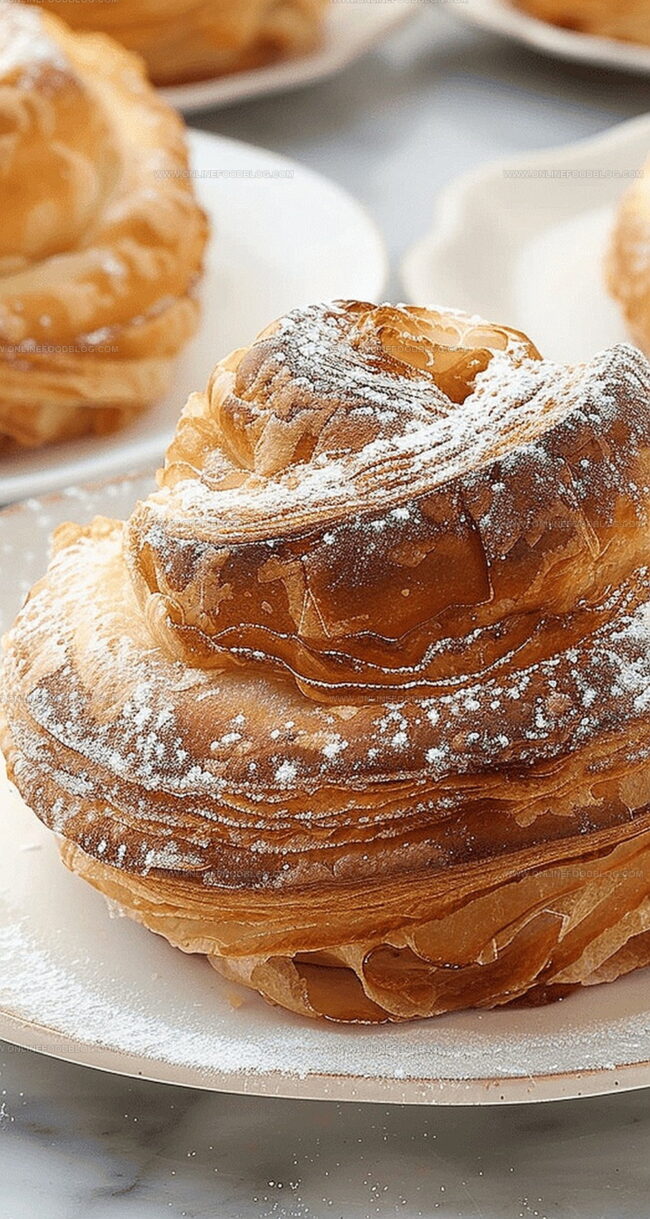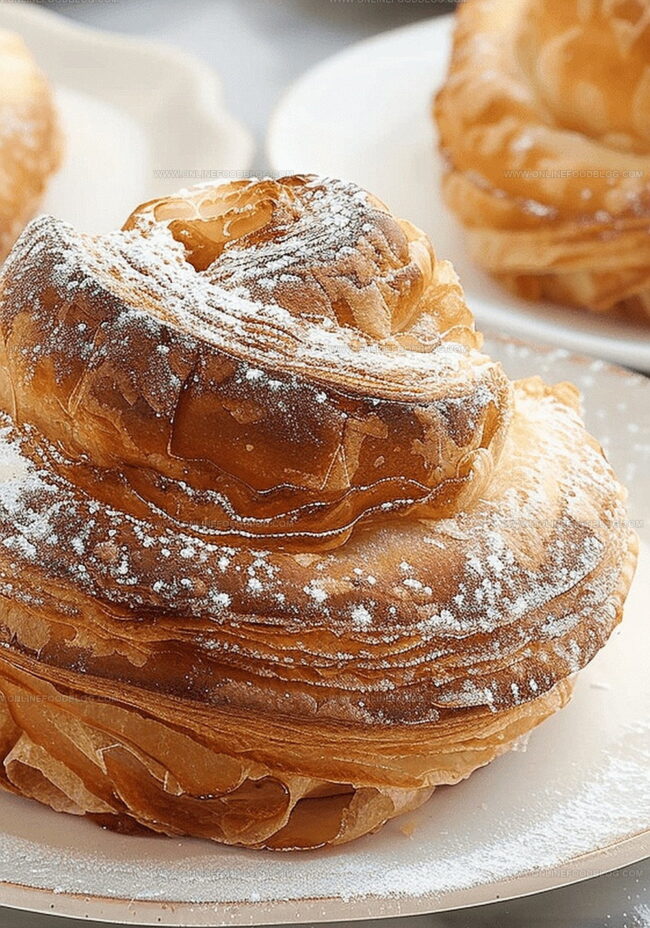Lazy Baker’s Dream: Cheater Croissant Dough Recipe
Baking delicate, buttery croissants with this foolproof cheater croissant dough recipe feels like unlocking a secret pastry chef skill.
Professional bakeries guard their techniques, but now you can create flaky, golden layers at home with minimal effort.
This shortcut method slices through traditional complexity, making laminated dough accessible to anyone with basic kitchen skills.
No advanced pastry training required—just simple ingredients and smart techniques.
Each fold and turn builds incredible texture that rivals café-quality pastries.
The process is surprisingly forgiving and delivers stunning results that will impress anyone who takes a bite.
Get ready to master bakery-level croissants without stress or complicated steps.
Quick Recipe Overview
Ingredient Guide for Cheater Croissant Dough
For Dough Base:For Dough Enrichment:For Laminating Layer:Equipment You’ll Need for Flaky Croissants
Step-by-Step for Making Croissant Dough
Seductive Croissant Magic
Dissolve yeast in warm water, letting it bloom and come alive with potential. Wait patiently until the mixture looks slightly foamy and fragrant.
Mix flour, sugar, and salt in a stand mixer. Gently incorporate water-yeast mixture and melted butter until a rough, shaggy dough forms. Allow the dough to rest and rise at room temperature, transforming into a puffy, voluminous mass.
Shape the risen dough into a smooth rectangle on plastic wrap. Chill in the refrigerator, letting the gluten relax and flavor develop overnight.
Create a luxurious butter block by blending European butter with a touch of flour until creamy and spreadable.
Roll out the chilled dough and spread the butter mixture across its surface. Perform precise letter folds, creating delicate, buttery layers that will become the signature of your croissants.
Alternate between gentle rolling and strategic folding, chilling the dough between turns to maintain perfect texture. Each fold creates more intricate, flaky layers.
Wrap the completed dough carefully, ready to be transformed into beautiful, golden croissants or stored for future baking adventures.
Pro Tips to Perfect That Cheater Dough
Fun Ways to Serve Homemade Croissants
Make-Ahead & Storage Plan for Croissants
Print
Buttery Croissant Dough Recipe
- Total Time: Varies based on steps
- Yield: 13 1x
Description
Quick homemade croissant dough delivers buttery, flaky pastry perfection without complex traditional techniques. Professional bakers and home cooks can craft delicious croissants with minimal effort and maximum satisfaction.
Ingredients
- 1 ½ cups (3 sticks or 339 g) unsalted European butter (preferably 82 percent butterfat), at room temperature (68°F / 20°C) and pliable
- 4 cups plus 1 tbsp (577 g) all-purpose flour
- 1 ½ cups (360 g) warm water (100 to 110°F / 35 to 42°C)
- ¼ cup plus 1 tbsp (65 g) granulated sugar
- 2 tsp salt
- 1 tbsp plus 1 tsp active dry yeast
- 2 tbsps unsalted butter, melted
Instructions
- Yeast Activation: Dissolve yeast in warm water, allowing it to bloom and become frothy for precise fermentation.
- Dough Formation: Blend flour, sugar, and salt in a stand mixer. Integrate water-yeast mixture and melted butter until a cohesive, shaggy dough emerges.
- Initial Proofing: Transfer dough to a greased bowl, envelop with plastic wrap, and let rise at ambient temperature until volume doubles, roughly 1½ to 2 hours.
- Dough Preparation: Gently collapse dough, shape into a rectangular form on plastic wrap, and refrigerate for a minimum of 2 hours to develop structure.
- Butter Integration: Whip European butter with flour until achieving a smooth, uniform consistency for seamless incorporation.
- Lamination Process: Roll chilled dough into a expansive rectangle, spreading butter mixture evenly across the surface, maintaining a slight perimeter.
- Folding Technique: Execute initial letter fold by bringing bottom third upward, then folding top third downward, creating multiple delicate layers.
- Layering Enhancement: Rotate dough, roll into another rectangle, and perform a second letter fold to amplify structural complexity.
- Temperature Management: Briefly chill dough in freezer for 6 minutes to stabilize texture and maintain optimal plasticity.
- Final Lamination: Complete third letter fold, rolling and folding to create intricate, delicate pastry layers.
- Storage and Preparation: For immediate use, chill in freezer for 6 minutes. Alternatively, wrap and freeze up to 2 weeks, thawing in refrigerator when ready to use.
Notes
- Yeast Activation Tip: Ensure water temperature is lukewarm (around 110°F) to activate yeast effectively without killing it.
- Butter Preparation Hack: Use European-style butter with high-fat content for flakier, more authentic croissant texture.
- Chilling Strategy: Multiple short freezer breaks between folds help maintain butter’s cold temperature, crucial for creating distinct layers.
- Dough Flexibility Note: Can be prepared ahead and stored frozen up to 2 weeks, offering convenient meal planning and spontaneous baking options.
- Prep Time: Varies based on steps
- Cook Time: 0 minutes
- Category: Breakfast, Snacks, Desserts
- Method: Baking
- Cuisine: French
Nutrition
- Serving Size: 13
- Calories: 278
- Sugar: 5 g
- Sodium: 210 mg
- Fat: 16 g
- Saturated Fat: 10 g
- Unsaturated Fat: 6 g
- Trans Fat: 0 g
- Carbohydrates: 29 g
- Fiber: 1 g
- Protein: 5 g
- Cholesterol: 30 mg




Mia Reynolds
Food Writer & Home Cooking Specialist
Expertise
Easy Home Baking, Recipe Writing and Storytelling, Local and Seasonal Ingredients, Baking for Beginners
Education
New England Culinary Institute (NECI), Montpelier, Vermont
Community College of Vermont, Winooski, Vermont
Mia Reynolds fell in love with baking as a teenager experimenting in her family kitchen. Her passion took her to New England Culinary Institute, where she learned practical pastry techniques, and later to Community College of Vermont to deepen her understanding of food management.
Mia combines clear, simple baking instructions with heartwarming stories, making home baking approachable for everyone.